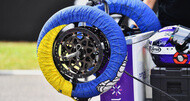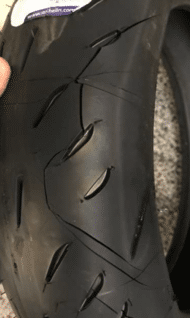You may not have heard of motorcycle tyre breakdown because it is a subject that is rarely discussed. Yet it is a significant topic for any kind of tyre, but specifically for racing tyres, especially if you handle and store them.
Why is it important? Because if the temperature of the tyres is not respected, it can cause serious damage to them even result in them becoming unsuitable for use.
In this article you will find out everything you need to know about the risks and precautions to take regarding motorcycle tyre breakdown.
What types of tyres are affected?
We are mainly talking here about very high performance tyres, in other words those used in extreme conditions like competition. Because of their ability to perform on the track at high temperatures, these tyres are particularly sensitive to cold and require special precautions, which we will explain below.
Motorcycle tyres designed for uses other than racing (road, off-road, commuting, etc.) are not designed in the same way and do not rise in temperature as much. They are therefore not as affected by the cold and do not require the same precautions.
Why are competition tyres affected by cold temperatures?
High performance tyres will take longer to reach the optimum temperature than conventional road tyres (which is why tyre warmers are often used to get the tyres to the right temperature before the start of the race), but they can withstand greater stresses and higher temperatures.

Tyre warmers are used to get the tyres to the right temperature before the start of the race
The more you constrain the tyre in its use, the more temperature-related risks will occur.
For track tyres, the very high temperatures encountered (related to the very high levels of grip) require a specific blend of tyre compounds to withstand them.
It is thanks to this compound that these tyres are able to maintain good performance even when heated to temperatures up to 150°.

Thanks to a specific blend of compounds, good tyre performance is maintained even at temperatures of up to 150°.
The downside is that they must not be exposed to cold temperatures. Because handling these tyres when they are cold may result in the tread or other area of rubber literally breaking as if it were glass.
Care must therefore be taken to store the tyres in appropriate conditions which avoid low temperatures. If this occurs, the tyres should not be handled at all.
The breaking point
It's a problem that every tyre manufacturer faces: when temperatures reach certain extremes, tyres inevitably lose their performance and also risk irreversible damage.
There is a low temperature threshold from which the rubber loses elasticity and becomes brittle. This is called the breaking point.
Rubber breakdown in the cold can appear inside the tyre only and so remain invisible. It can manifest itself as one small crack or many larger cracks all around the tyre.

An example of a rubber breakdown after the tyre has been exposed to low temperatures
The impact of temperature on performance
We have seen it, a tyre that has been subjected to low temperatures loses grip performance.
But there is also a high temperature threshold from which the rubber becomes pasty/viscous. It is called the reversion point. If the temperature of the tyre exceeds this threshold, the tyre will also have reduced performance.
However, the vast majority of our tyres operate within these thermal limits without impediment.
Different temperature thresholds for different ranges
As we will see in the table below, our different ranges of track tyres have different tolerance levels.

For transport and storage, the MICHELIN Power Performance range requires not to be handled below 10°C to avoid damage.
This threshold is reduced to 5°C for these ranges:
and to -10°C for these ranges:
For mounting or dismounting, it is advisable to have stored a MICHELIN Power Performance tyre for at least 24 hours in a place where the temperature is higher or equal to 15°C.
For MICHELIN Power Slick 2, MICHELIN Power Cup 2 and MICHELIN Power Cup EVO, the ambient temperature must be greater than or equal to 10°C for more than 24 hours before a mounting or dismounting operation.

MICHELIN Power Performance tyres should not be handled at temperatures lower than 10°C
How do you know the temperature of your tyres?
To check the temperature of a tyre, all you need to do is use a conventional thermometer. If the tyre has been stored for several hours in a room, it can be assumed that the temperature of the tyre is equivalent to the ambient temperature.
Excellent performance on track
Follow these simple precautions and you will enjoy excellent performance and unparalleled pleasure when riding your motorcycle on the track!
Choose the best track tyres for your motorcycle
MICHELIN POWER PERFORMANCE 24
Sports
Delivering race-winning pace hour after hour !
NON ROAD LEGAL
MICHELIN POWER PERFORMANCE SLICK
Sports
Delivering race-winning pace lap after lap!
NON ROAD LEGAL
MICHELIN POWER SLICK 2
Sports
Designed for maximum grip on the track
NON ROAD LEGAL
MICHELIN POWER CUP 2
Sports
Designed for the track, approved for the road
ROAD LEGAL(1)
MICHELIN POWER CUP EVO
Sports
The street legal tyre designed for track use on smaller capacity motorcycles
ROAD LEGAL
MICHELIN POWER 5
Roadster - Road
Sports

The sporty road tyre choice
MICHELIN POWER SUPERMOTO RAIN
Supermoto
Tyre for supermoto competitions even in the rain
NON ROAD LEGAL
MICHELIN POWER RAIN
Sports
The rain tyre for the track
NON ROAD LEGAL


